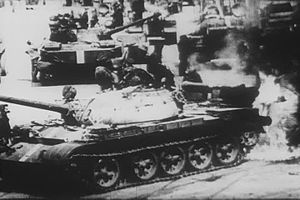Silent Revolutions: Difference between revisions
m (Added Sanarija) |
mNo edit summary |
||
| Line 46: | Line 46: | ||
* | * | ||
}} | }} | ||
The '''Silent Revolutions''' ([[Dazhdin language|Dazhdin]]: ''Tihyje Revolucje''; [https://anglish.fandom.com/wiki/What_is_Anglish%3F Velaharian]: ''Sooþe Overhaul'') were a series of unsuccessful peaceful revolutions, that swept through the at the time socialist nations in southern [[Argis]]. The revolutions themselves began with escalating protests, which later gained popular traction, gaining over a million protesters on the largest gatherings. The turning point of the revolutions is considered to be the evening of 24th November 1989, one day before the planned international [[wikipedia:General strike|general strike]], when the army figures were given orders to open fire into the demonstrators against the demonstrators and [[wikipedia:Martial law|martial law]] was declared, with tens of thousands of suspects being arrested in the night from 24th to 25th November and being [[wikipedia:Indefinite detention|jailed without trial]] in makeshift detention centers. Eventually, the martial laws were lifted between mid 1990 and early 1992. | The '''Silent Revolutions''' ([[Dazhdin language|Dazhdin]]: ''Tihyje Revolucje''; [https://anglish.fandom.com/wiki/What_is_Anglish%3F Velaharian]: ''Sooþe Overhaul'') were a series of unsuccessful peaceful revolutions, that swept through the at the time socialist nations in southern [[Argis]] of [[Dazhdinia]], {{EUN|1436-sanarija}} and [[Velaheria]]. The revolutions themselves began with escalating protests, which later gained popular traction, gaining over a million protesters on the largest gatherings. The turning point of the revolutions is considered to be the evening of 24th November 1989, one day before the planned international [[wikipedia:General strike|general strike]], when the army figures were given orders to open fire into the demonstrators against the demonstrators and [[wikipedia:Martial law|martial law]] was declared, with tens of thousands of suspects being arrested in the night from 24th to 25th November and being [[wikipedia:Indefinite detention|jailed without trial]] in makeshift detention centers. Eventually, the martial laws were lifted between mid 1990 and early 1992. | ||
==History== | ==History== | ||
===Early protests=== | ===Early protests=== | ||
Revision as of 10:14, 28 September 2021
This article is incomplete because it is pending further input from participants, or it is a work-in-progress by one author. Please comment on this article's talk page to share your input, comments and questions. Note: To contribute to this article, you may need to seek help from the author(s) of this page. |
| Silent Revolutions | |||
|---|---|---|---|
 Dazhdin secret service opening fire into demonstrators | |||
| Date | 5 September 1989 – 7 January 1990 (4 months and 2 days) | ||
| Location | Communist nations of Argis | ||
| Caused by | |||
| Goals |
| ||
| Methods |
| ||
| Resulted in | Violent suppression of protests
| ||
| Parties to the civil conflict | |||
| Lead figures | |||
| |||
The Silent Revolutions (Dazhdin: Tihyje Revolucje; Velaharian: Sooþe Overhaul) were a series of unsuccessful peaceful revolutions, that swept through the at the time socialist nations in southern Argis of Dazhdinia, Sanarija and Velaheria. The revolutions themselves began with escalating protests, which later gained popular traction, gaining over a million protesters on the largest gatherings. The turning point of the revolutions is considered to be the evening of 24th November 1989, one day before the planned international general strike, when the army figures were given orders to open fire into the demonstrators against the demonstrators and martial law was declared, with tens of thousands of suspects being arrested in the night from 24th to 25th November and being jailed without trial in makeshift detention centers. Eventually, the martial laws were lifted between mid 1990 and early 1992.
History
Early protests
TBA
Escalating movement
TBA
Plans for general strike
TBA
Military crackdown
TBA
Changes in garniture
TBA
Violent protests

TBA
Arrests and detentions
TBA
Detention centers
TBA
Punishments
TBA
Later incidents
TBA
Political stabilisation
TBA
Aftermath
TBA
In popular culture
TBA
